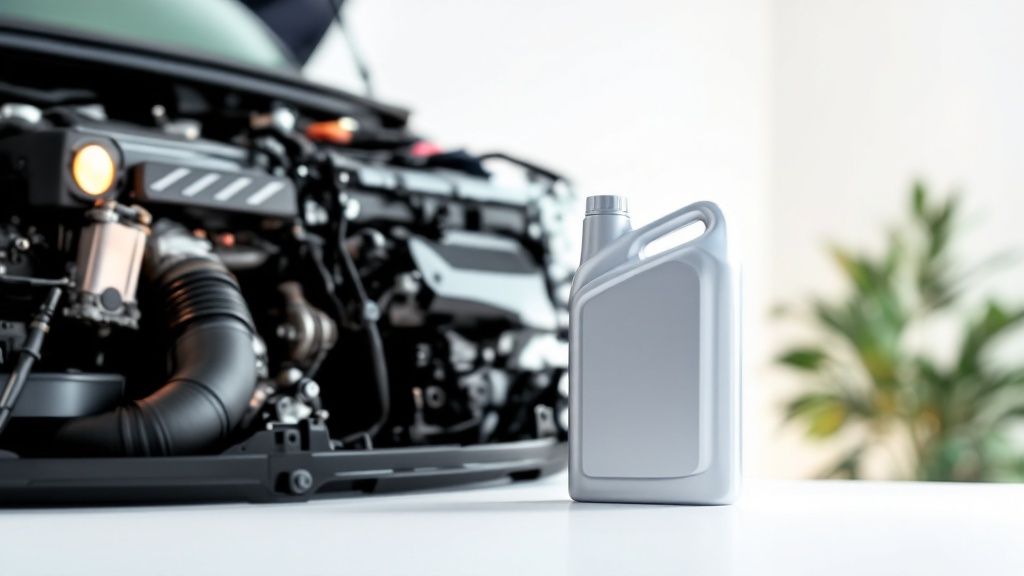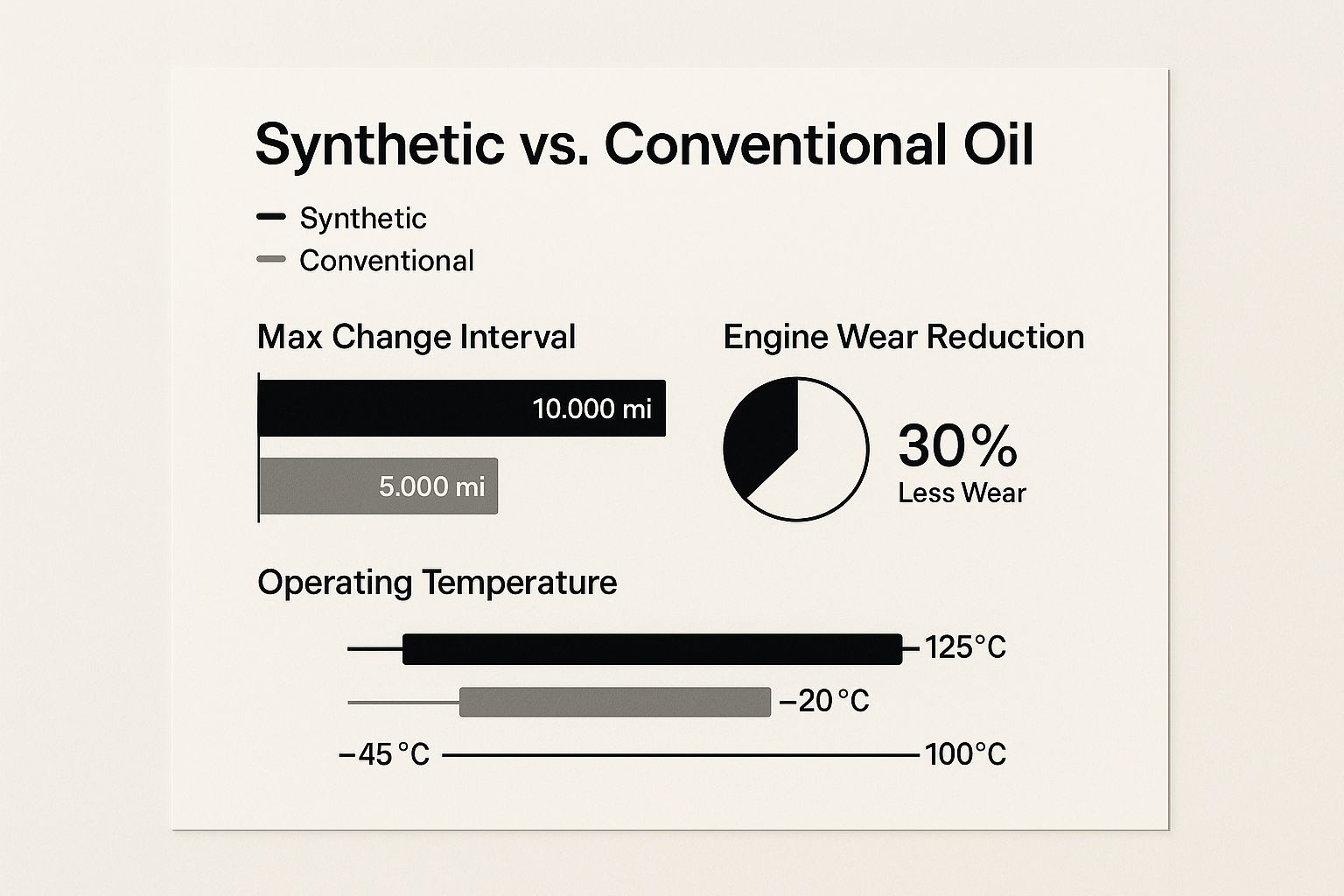
Synthetic oil boasts a longer lifespan than conventional oil. This difference stems from their distinct molecular structures. Conventional oil, derived directly from crude oil, comprises a mixture of hydrocarbon molecules of varying lengths and shapes. This inconsistency increases its susceptibility to thermal breakdown, leading to sludge and deposit formation. Consequently, conventional oil necessitates frequent changes.
Synthetic oil, conversely, is meticulously engineered at the molecular level. This process yields uniform, high-performance molecules resistant to thermal breakdown and capable of maintaining viscosity across a broader temperature range. Consequently, synthetic oil can operate for extended periods without replacement, surpassing conventional oil's longevity. Imagine constructing a tower with LEGOs. Conventional oil resembles using a mix of different-sized blocks, resulting in a less stable structure. Synthetic oil, on the other hand, is akin to using identical, precisely engineered blocks, creating a stronger, more durable tower.
The enhanced stability of synthetic oil directly translates to longer synthetic oil change intervals. This translates to fewer oil changes, reduced waste oil, and potentially lower maintenance costs over your vehicle's lifespan. This benefit is particularly advantageous for drivers operating in demanding conditions, such as extreme temperatures or stop-and-go traffic, where conventional oil would degrade more rapidly.
Historically, recommended oil change intervals have undergone significant adjustments, especially with the advent of synthetic oil. Past recommendations for conventional oil were typically shorter, around 3,000 to 5,000 miles. However, advancements in synthetic oil technology have extended these intervals.
Modern vehicles using synthetic oil often have change intervals between 7,500 and 10,000 miles, with some manufacturers recommending intervals as long as 12,000 or even 16,000 miles. This shift toward longer intervals underscores the superior durability and performance of synthetic oil compared to its conventional counterpart. The EPA's influence on automakers around 2010 also contributed to standardizing these extended intervals, aiming to reduce oil consumption and enhance fuel efficiency. Explore this topic further here.
Furthermore, modern engine design contributes to the feasibility of extended synthetic oil change intervals. Tighter tolerances and advanced materials necessitate higher-quality lubricants capable of withstanding increased stress and heat. Synthetic oil excels in these demanding environments.
Many newer vehicles incorporate oil life monitoring systems. These systems consider driving conditions and engine performance to provide more accurate oil change recommendations. This departure from the traditional "3,000-mile" rule reflects advancements in both oil technology and engine design.
Understanding the science behind synthetic oil illuminates its advantages and explains its crucial role in modern vehicle maintenance. It empowers car owners to make informed decisions about their vehicle's care, potentially saving money in the long run. These fundamental principles will guide us as we explore the often-misunderstood world of manufacturer recommendations and their true implications for your vehicle.
It's essential to understand oil change frequency. Manufacturers typically provide recommendations, and a good starting point is your owner's manual. However, there's more to the story, especially when it comes to synthetic oil. Manufacturers often incorporate significant safety margins into their suggested change intervals. This cautious approach helps protect them from warranty issues related to neglected maintenance. But for many drivers, these overly conservative intervals could mean unnecessary oil changes.
Understanding how these guidelines are developed helps us interpret them effectively. Factors like anticipated driving conditions, expected vehicle lifespan, and legal obligations all play a role in shaping the recommendations. Manufacturers also have to account for varying driver behavior, from meticulous car care to occasional neglect.
Many owner's manuals differentiate between "normal" and "severe" driving conditions. "Severe" conditions, which often include stop-and-go city driving, short trips, and extreme temperatures, usually call for more frequent oil changes. This distinction aims to address the increased stress placed on the oil under these circumstances.

This infographic compares key aspects of synthetic and conventional oil, illustrating their maximum change intervals, the reduction in engine wear they provide, and their respective operating temperature ranges. The data clearly shows the extended performance capabilities of synthetic oil, particularly its broader temperature tolerance and significantly longer change intervals compared to conventional oil. This translates to fewer oil changes and potential cost savings over time.
Furthermore, statistical data backs up the long-lasting effectiveness of synthetic oil. In fleet management, switching to synthetic oil has enabled some fleets to significantly extend service intervals from 4,000 to 6,000 miles, with goals of reaching 10,000 to 15,000 miles. This not only lowers maintenance expenses but can also boost vehicle efficiency. Studies also suggest synthetic oil can remain effective for up to two years, depending on the oil's quality and driving conditions. This extended lifespan is a key reason many car owners are making the switch to synthetic oil. Learn more about oil change interval statistics here.
This means you might be able to extend your synthetic oil change interval beyond what the manufacturer recommends, particularly if your driving habits fall under the "normal" category. Factors like your vehicle's age, design, and your individual driving style are all important considerations for determining the optimal interval. By understanding these factors, you can make informed decisions about your car's maintenance, striking a balance between cost-effectiveness and protecting your engine.
To illustrate the variation in manufacturer recommendations, let's look at the following table:
Manufacturer Recommended Synthetic Oil Change Intervals This table compares synthetic oil change interval recommendations from major vehicle manufacturers, demonstrating the differences between brands and model years.
| Manufacturer | Model Years | Normal Conditions (miles) | Severe Conditions (miles) | Maximum Time Period |
|---|---|---|---|---|
| Example 1 | 2020-2023 | 10,000 | 5,000 | 1 year |
| Example 2 | 2020-2023 | 7,500 | 3,000 | 6 months |
| Example 3 | 2020-2023 | 12,000 | 7,500 | 1 year |
| Example 4 | 2018-2021 | 8,000 | 4,000 | 6 months |
As you can see, recommended oil change intervals can differ significantly. Consulting your owner's manual and considering your driving habits will help you determine the appropriate schedule for your vehicle.

Your driving habits play a significant role in how long your synthetic oil lasts. While synthetic oil generally offers longer intervals between changes compared to conventional oil, certain driving styles can contribute to premature degradation. Understanding these factors is key to getting the most out of your synthetic oil and ensuring your engine stays protected.
Short trips and stop-and-go city driving are tough on engine oil. The engine doesn't reach its ideal operating temperature, which prevents the oil from fully circulating and removing moisture and contaminants. This can result in sludge buildup and reduce the oil's effectiveness. It's similar to brewing coffee without letting the water boil—you get a weaker result. Similarly, short trips don't allow the synthetic oil to function at peak performance.
Idling for extended periods, like in heavy traffic or during deliveries, also contributes to oil breakdown. The engine generates heat, but the oil isn't circulating efficiently, leading to faster degradation. Towing heavy loads or frequent uphill driving puts additional strain on the engine, forcing the oil to work harder and potentially shortening its lifespan.
Both high and low extreme temperatures impact oil life. High temperatures accelerate oil oxidation, while cold temperatures can thicken the oil, hindering circulation. These conditions can classify your driving as "severe service," as defined in your owner's manual, which often requires more frequent oil changes. While this affects all types of oil, synthetic oil's longer lifespan offers a greater buffer against these challenging conditions. This resilience is a major benefit of synthetic oils. Globally, the increasing popularity of synthetic oil is linked to its potential for extending oil change intervals, sometimes even tripling them. In industrial applications, for example, Mobil synthetic oils have been shown to extend oil change intervals from 1,500 hours to 4,500 hours, reducing downtime and costs. This benefit translates to consumer vehicles as well, where synthetic oil supports longer change intervals. More detailed statistics on this can be found here.
Understanding your driving patterns helps you determine the best synthetic oil change interval for your vehicle. While manufacturer recommendations are a useful starting point, adjusting them based on your individual driving habits optimizes both engine protection and maintenance expenses. If you primarily drive on the highway in moderate temperatures, you might be able to extend your oil change interval. Conversely, frequent city driving in extreme heat might require more frequent changes. Always consult your owner’s manual and consider your specific driving style to make informed decisions about your vehicle’s maintenance.
Is premium synthetic oil really worth the extra money? The answer goes beyond the price per quart. This section dives into the full financial picture, looking past the sticker shock of an oil change. We'll analyze the economics of different oil change strategies, including not just oil, filters, and labor, but also often-forgotten factors like vehicle depreciation, fuel efficiency, and the long-term health of your engine.
Understanding the true economics of synthetic oil change intervals means considering a wide range of factors, including strategies to reduce production costs. While synthetic oil has a higher initial cost than conventional oil, the ability to extend your oil change interval results in fewer changes over time. This directly affects your yearly maintenance budget and influences other costs as well. Fewer oil changes translate to less money spent on oil filters and labor.
Another factor to consider is your vehicle's resale value. A well-maintained engine, documented with regular, though less frequent, synthetic oil changes, can be a strong selling point. This can potentially balance out the initially higher cost of synthetic oil. Plus, synthetic oil's superior lubrication can boost fuel economy. While the improvement might seem small per fill-up, the accumulated savings can add up significantly over the lifespan of your vehicle.
To make smart choices, we need to put numbers to these economic advantages. The following table provides a cost comparison between standard and extended synthetic oil change intervals, based on driving 12,000 miles annually.
This table compares the annual costs of different oil change interval strategies based on average driving distances and oil types.
| Strategy | Annual Changes | Cost Per Change | Annual Cost | Time Investment | Long-term Engine Benefits |
|---|---|---|---|---|---|
| Standard Interval (every 5,000 miles with conventional oil) | 2-3 | $40 | $80-$120 | More Frequent | Standard |
| Extended Interval (every 7,500 miles with synthetic oil) | 1-2 | $70 | $70-$140 | Less Frequent | Enhanced Protection |
| Extended Interval (every 10,000 miles with synthetic oil) | 1 | $70 | $70 | Least Frequent | Maximum Protection |
As the table shows, extended intervals offer potential savings, especially when you factor in reduced time spent on maintenance and the long-term benefits for your engine.
While stretching the time between oil changes is appealing, striking the right balance is essential. Extending your synthetic oil change interval too much can undermine the protective qualities of the synthetic oil. Understanding your driving habits and their effect on oil life is key. The next section will explore how your individual driving style impacts your oil's performance, helping you determine the optimal oil change frequency for your specific needs and maximize the value of using synthetic oil.

Even with the longevity of synthetic oil, your car might occasionally need attention sooner than anticipated. This section covers the crucial warning signs that require immediate action, regardless of your mileage or the time since your last oil change. Ignoring these signs could result in serious engine damage.
One of the earliest signs of oil problems is unusual engine noise. A knocking or ticking sound, especially when the engine is cold, could mean inadequate lubrication. This is crucial with synthetic oil, designed to retain its viscosity at low temperatures.
Any new grinding or whining sounds also warrant immediate investigation. These could indicate metal-on-metal contact due to low oil levels.
Changes in engine performance are another red flag. If your car feels sluggish, struggles to accelerate, or hesitates, degraded oil might be the culprit. Synthetic oil, with its consistent viscosity, is essential for smooth engine function.
A noticeable performance dip suggests the oil isn't doing its job. For instance, hesitation when accelerating from a stop, when the car normally accelerates smoothly, could signal an oil-related issue.
Regularly checking your oil offers valuable insights into your engine’s health. Look at the oil's color, consistency, and smell. Fresh synthetic oil typically has a clear amber hue.
Dark, gritty, or burnt-smelling oil indicates contamination and requires immediate attention. Think of it like checking the expiration date on food. A visual check can often tell you if it's still good. Similarly, checking your oil’s condition offers a quick and easy way to gauge its health.
Most modern vehicles have oil life monitoring systems. These systems offer personalized change recommendations based on your driving habits. However, certain dashboard warning lights, such as the check engine light or a low oil pressure warning, should never be ignored.
The check engine light can indicate various problems, sometimes including oil-related issues needing immediate attention. A low oil pressure warning is a serious sign that the oil isn't circulating properly and demands immediate investigation.
By recognizing these warning signs, you can anticipate potential issues and protect your engine. This proactive approach helps maximize the benefits of your synthetic oil change interval while preventing costly repairs. Addressing these issues promptly can save you money and keep your vehicle running smoothly.
The world of synthetic lubricants is constantly changing. New technologies promise to extend synthetic oil change intervals, meaning fewer trips to the mechanic and potential cost savings over your vehicle's lifespan.
Advances in molecular engineering are creating tougher, more resilient synthetic oils. These oils handle higher temperatures and pressures, slowing down degradation. Researchers are even developing self-healing oils. These contain microscopic capsules that release additives as needed, repairing minor damage and extending the oil's life. Imagine a self-sealing tire constantly mending small punctures – self-healing oils could offer similar continuous protection and dramatically longer intervals between oil changes.
Adaptive additive packages are another exciting area of development. These additives change their properties based on real-time engine conditions, offering optimal protection in various driving situations. For example, in stop-and-go traffic, the additives might thicken to reduce friction and wear. At high speeds, they could thin out to boost fuel economy. These "smart" additives could considerably lengthen synthetic oil change intervals.
Complementing these advancements are real-time oil monitoring systems. These use sensors and onboard computers to analyze oil quality and predict its remaining lifespan. Unlike traditional mileage-based recommendations, these systems create maintenance schedules tailored to your driving habits. You'll change your oil only when truly necessary, avoiding premature changes and getting the most out of your synthetic oil.
The growing popularity of hybrid and electric vehicles (EVs) is also shaping the future of synthetic oil. While these vehicles typically need less frequent oil changes than traditional gasoline cars, they still use lubricants for essential components. EV batteries use specialized cooling oils, presenting new opportunities for synthetic lubricant development. The unique operating conditions of electric motors demand oils with specific electrical properties, driving innovation in the synthetic oil industry.
Modern engine designs are placing higher demands on lubricants. Newer engines often run at higher temperatures and pressures, requiring oils with excellent thermal stability and viscosity retention. Synthetic oil is well-suited to meet these demands. Its engineered molecular structure provides a strong base for advancements in oil performance, potentially extending synthetic oil change intervals even further. This could also influence manufacturer recommendations. As technology progresses, we might see a shift toward personalized, data-driven oil change advice.
The future of synthetic oil points towards longer change intervals, enhanced engine protection, and improved efficiency. Staying informed about these developments helps you prepare for the changing landscape of vehicle maintenance and make smart choices about your car's care.
Ready for the benefits of premium synthetic oil and expert service? Visit Kwik Kar Oil Change and Auto Care today to schedule your next oil change. Our skilled technicians stay current with the latest in synthetic oil technology and can help you select the ideal oil for your car.